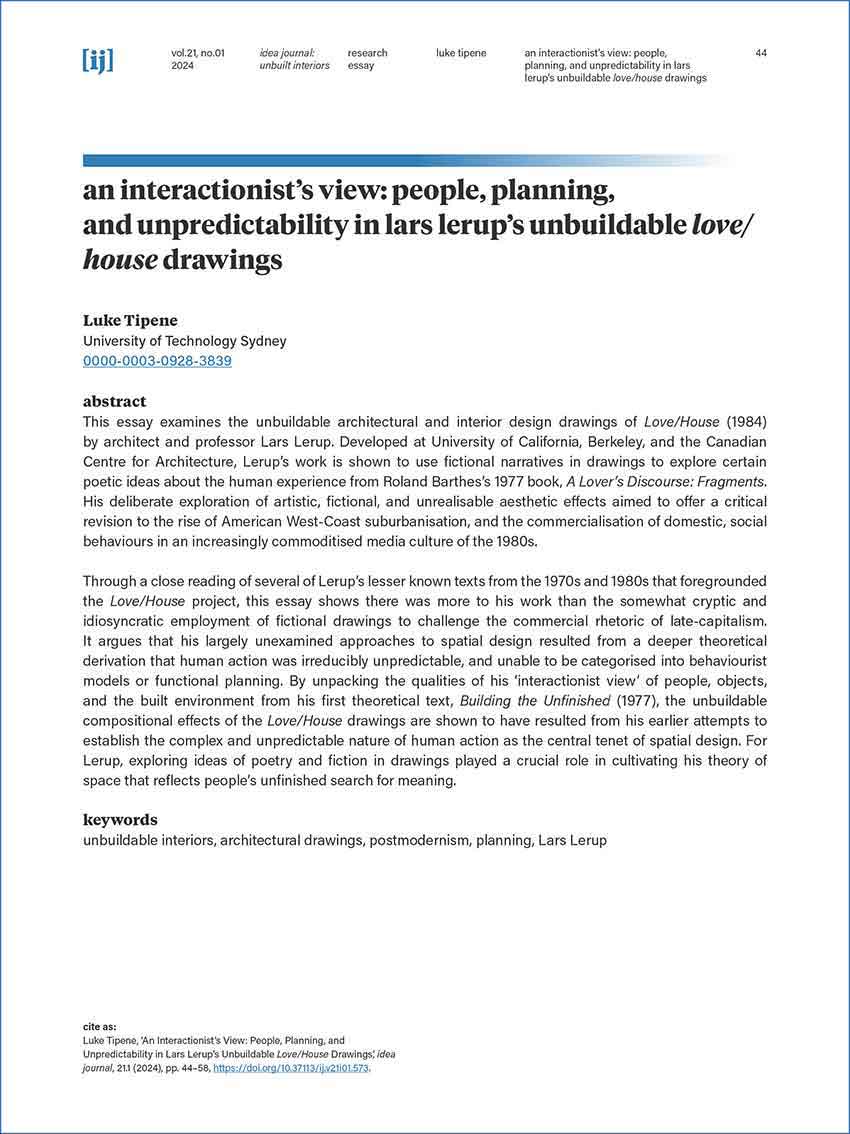An Interactionist’s View People, Planning, and Unpredictability in Lars Lerup’s Unbuildable Love/House Drawings
Main Article Content
Abstract
This essay examines the unbuildable architectural and interior design drawings of Love/House (1984) by architect and professor Lars Lerup. Developed at University of California, Berkeley, and the Canadian Centre for Architecture, Lerup’s work is shown to use fictional narratives in drawings to explore certain poetic ideas about the human experience from Roland Barthes’s 1977 book, A Lover’s Discourse: Fragments. His deliberate exploration of artistic, fictional, and unrealisable aesthetic effects aimed to offer a critical revision to the rise of American West-Coast suburbanisation, and the commercialisation of domestic, social behaviours in an increasingly commoditised media culture of the 1980s.
Through a close reading of several of Lerup’s lesser known texts from the 1970s and 1980s that foregrounded the Love/House project, this essay shows there was more to his work than the somewhat cryptic and idiosyncratic employment of fictional drawings to challenge the commercial rhetoric of late-capitalism. It argues that his largely unexamined approaches to spatial design resulted from a deeper theoretical derivation that human action was irreducibly unpredictable, and unable to be categorised into behaviourist models or functional planning. By unpacking the qualities of his ‘interactionist view’ of people, objects, and the built environment from his first theoretical text, Building the Unfinished (1977), the unbuildable compositional effects of the Love/House drawings are shown to have resulted from his earlier attempts to establish the complex and unpredictable nature of human action as the central tenet of spatial design. For Lerup, exploring ideas of poetry and fiction in drawings played a crucial role in cultivating his theory of space that reflects people’s unfinished search for meaning.
Article Details
Author/s and or their institutions retain copyright ownership over works submitted to Idea Journal, and provide the Interior Design / Interior Architecture Educators Association with a non–exclusive license to use the work for the purposes listed below:
- Make available/publish electronically on the Idea Journal website
- Publish as part of Idea Journal's online open access publications
- Store in electronic databases, on websites and CDs/DVDs, which comprise of post-publication articles to be used for publishing by the Interior Design / Interior Architecture Educators Association.
Reproduction is prohibited without written permission of the publisher, the author/s or their nominated university. The work submitted for review should not have been published or be in the process of being reviewed by another publisher. Authors should ensure that any images used in their essays have copyright clearance.

